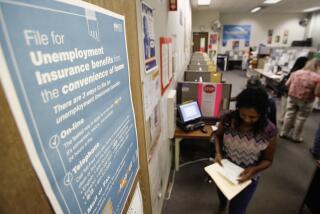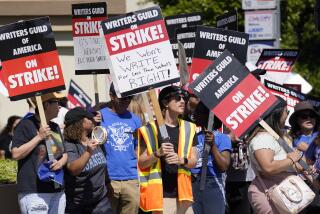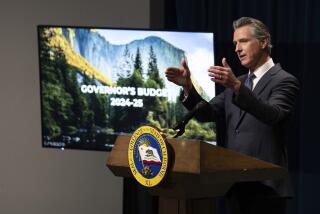Jobless Fund Crisis to Hit Employers
- Share via
SACRAMENTO — The pool of money California uses to give weekly checks to the unemployed has plummeted from $6 billion in 2002 to less than half a billion dollars, forcing the state to seek a federal bailout, raise the rates employers pay into the fund and consider decreasing benefits to laid-off workers.
Starting in January, California employers -- from small businesses to major corporations -- can expect to pay an additional $2 billion a year into the unemployment fund, but even that won’t be enough, officials say.
The state asked the federal government Wednesday for a $1.3-billion loan, marking the first time California has been forced to do so. Without the federal bailout, the fund would be more than $1 billion in the hole by the end of 2004.
The fund pays up to $370 a week to workers who lose their jobs through no fault of their own. This year, an estimated 2.2 million claims were filed. The benefits are paid entirely by employers.
The average California employer can expect a 50% increase in the rates paid for unemployment benefits beginning in January, and they will also be on the hook to pay back the federal loan.
To the double-barreled bad news, employers respond: We told you so.
They blame the dwindling unemployment insurance fund on lawmakers and former Gov. Gray Davis, who boosted weekly payments for the out-of-work in 2002 despite warnings that the increase could push the unemployment fund into insolvency. The California Chamber of Commerce estimates the cost of the increased benefits over five years at $12.7 billion.
State employment officials say the sluggish economy and an increase in the average length of time people stay on unemployment also have squeezed the fund.
“The benefit increases were so steep,” said Julianne A. Broyles, director of employee relations and small businesses for the California Chamber of Commerce. “Coupled with a shaky economy, it’s led us to the insolvency we have today.”
The money crunch in the unemployment insurance fund has gotten scant attention in Sacramento, where lawmakers have been busy trying to overhaul workers’ compensation insurance. Recently, rates for workers’ comp have doubled or more for many employers, from lumberyard owners to police agencies.
Assemblyman Keith Richman (R-Northridge) said last week that he had asked the Assembly Insurance Committee to hold hearings on the unemployment fund and was told the matter would be taken up in January.
“We need to discuss immediate actions that we need to take to maintain the solvency of the fund,” Richman said. “It’s another severe financial problem for the state of California.”
In sheer numbers, the $29-billion workers’ compensation system is a far greater burden on employers than the $3-billion unemployment insurance system. But a $2-billion-a-year increase in unemployment insurance costs in 2004 would offset a big chunk of the $5 billion in savings the Legislature expects to come from recent laws capping medical payments in the workers’ compensation system.
“They’re both mandatory, they’re both borne solely by the employer, and both have the same thread in that the only way for the employer to reduce their cost is to reduce their payroll,” said Allan Zaremberg, president of the California Chamber of Commerce.
The dwindled fund is another financial headache inherited by Gov. Arnold Schwarzenegger. Though the cost of unemployment insurance was not a prominent issue in his campaign to oust Davis, Schwarzenegger promised to protect California businesses from an increased tax burden.
Business leaders are pinning their hopes on Schwarzenegger, who complained in his inaugural address that next year California will have the highest unemployment insurance costs in the nation.
They seek a temporary suspension of the $40-a-week boost in jobless benefits scheduled to go into effect in January and a tightening of what they call the nation’s loosest rules for getting unemployment compensation.
Others call California’s problem more fundamental. They say the state’s current troubles stem from the perverse method used to fund jobless benefits. It fails in good economic times to set aside money and it taxes employers most heavily in economic downturns when they can least afford it, said Maurice Emsellem, policy director of the National Employment Law Project in Oakland.
“They squeeze everything out of the fund in good economic times -- rather than raise revenue -- and then they try to take it out of workers in bad economic times,” he said. “California’s benefits right now, after these increases, rank 46th in the nation when the average benefit is measured against the average wage.”
States with “pay as you go” systems like California’s have found themselves in big trouble lately and have needed to borrow federal money, Emsellem said.
Since 2002, New York, Texas, Minnesota, Missouri, Illinois and North Carolina all have sought federal bailouts.
The unemployment funds in states with a rate structure that builds higher reserves, such as Oregon, are not in danger of insolvency even though some have an even higher rate of unemployment than California, said Emsellem.
California’s unemployment insurance system, like that of other states, dates to the 1933 federal Social Security Act.
How much employers contribute for each person they hire depends in part on the company’s past experience in using the unemployment fund. Industries with frequent layoffs, such as agriculture, pay a higher percentage than industries with more stable employment, up to a maximum of 5.4% of the first $7,000 that each worker earns.
The state Chamber of Commerce estimates that the average employer will pay an additional $136 per worker yearly starting in January.
Legislation signed in 2002 requires state employment officials to study the merits of restructuring the system and submit a report by the end of this year.
Possible measures to save money include raising eligibility requirements -- a Californian is eligible for unemployment after earning $1,125 -- or making employers pay unemployment taxes on a greater portion of their workers’ earnings. California’s taxable wage base is the federal minimum of $7,000, compared to $26,000 in Oregon or $29,700 in Washington.
“We need to look at every aspect of the unemployment insurance program and find means of bringing stability that works for both the employers and the unemployed workers that the program serves,” said Rick Rice, assistant secretary of the California Labor and Workforce Development Agency.
“Based on the information gathered by the departments and the proposals submitted,” he said, “the Schwarzenegger administration will take action to bring fiscal stability to the system.”
More to Read
Inside the business of entertainment
The Wide Shot brings you news, analysis and insights on everything from streaming wars to production — and what it all means for the future.
You may occasionally receive promotional content from the Los Angeles Times.










